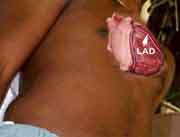In the Right Anterior Oblique or RAO-Caudal view, the camera
is rotated along a vertical axis towards the patient's right and also
along the vertical axis away the head and downwards or caudal, as
shown on the right pictures. above. The heart, as "seen" by
the image intensifier/camera assembly is shown on the left (above). Once
again, the size of the heart has been purposely exaggerated
for purposes of illustration. Please remember that the
ventricular septum lies in a plane between the right shoulder and the
left nipple. Thus, in the RAO view, the camera "looks" at the outline
of the septum, but from a point of view that is lower than that of the
RAO view. In other words, the camera looks at the outline of the septum,
from below. In the RAO-Caudal views, the LAD begins close to the spine
and then moves away from it and towards the left ventricular apex.
The diagonal (Dx) moves laterally away from the LAD. The septal
perforators (SP) are smaller branches that come off the inferior border
of the LAD and travel downwards and medially.
The Cx, in the
RAO-caudal view, moves away from the LAD and towards the spine before
giving off its branches that curve downwards and inferiorly running roughly
parallel to the LAD and diagonal coronary arteries. |


